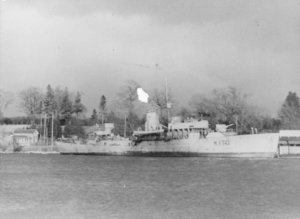
The “Bangor” minesweeper HMCS MULGRAVE was laid down on 15 December 1941 in the yards of the Port Arthur Shipbuilding Co., Port Arthur, Ontario, launched on 2 May 1942 and commissioned on 4 November 1942. The ship was named after Mulgrave or Port Mulgrave, a community and roadstead on the Gut of Canso in Guysborough County, Nova Scotia, which was in turn named in 1858 in honour of the Earl of Mulgrave who was Lieutenant-Governor of the province at the time.
Since in 1942 the need was for escort ships rather than minesweepers, MULGRAVE began her career working with convoys in coastal runs. Allocated first to the Halifax Local Escort Force, she escorted convoys between Halifax and Saint John, N.B. Then, transferred in March 1943 to Escort Group W-2 in the Western Local Escort Force, she conducted merchant ships to the West Ocean Meeting Point, turned them over to ships of the Mid-Ocean Escort Force and, after refuelling at St. John’s, Newfoundland, picked up west-bound convoys for the return voyage to Halifax.
She found the opportunity to perform the minesweeping duties for which she had been built when she was chosen to be one of the minesweepers to clear the path of the assault force which was to drive the German forces out of France and bring about their final defeat. She left Halifax with other Bangors on 18 February 1944. She ran into her first portent of misfortune on the 29th when, while proceeding into Horta in the Azores for fuel, she ran aground, despite having a Portuguese pilot aboard. Escorted by HMC Frigate VALLEYFIELD and HMC Corvette REGINA, she was towed by HM Rescue Tug Flaunt to the Clyde in Scotland for repairs. It would be a tragic coincidence that in less than five months, her two escorts would be sent to the bottom and she, not long after, would be irredeemably crippled.
During the spring of 1944 MULGRAVE worked up first with the Royal Navy’s 14th Minesweeping Flotilla and then joined other HMC Bangors in the all-Canadian 31st Minesweeping Flotilla. On 5 June she sailed with the Flotilla to sweep the path for the greatest naval operation of all time, the invasion of the French coast. After the big ships had followed along the swept channels and opened their bombardments on enemy installations, she was lying at anchor. The German batteries responded to the attack and she had a narrow escape when a shell from one of them missed her by a scant hundred yards.
From 8-11 June the Flotilla swept up a total of eighty-five mines. Fourteen of these were cut adrift by MULGRAVE. During the next few months she was active on convoy escort duty as well as regular sweeping operations in the Solent, Baie de la Seine and Cherbourg area.
Disaster struck her on Sunday, 8 October. She was at anchor off Arromanches with her Flotilla, when at 0555Z the ships weighed and proceeded in line ahead to carry out Operation “Pilgrim”, a sweep from Le Havre to Dieppe. Two hours later, at 0749Z, she was shaken by a violent explosion under her starboard quarter. Enveloped in a cascade of water and escaping steam, she began to settle slowly by the stern. She was then roughly eleven miles due west of Le Havre. Fortunately, casualties were light: only two men wounded. Damage control parties went into operation; when shoring-up was completed, the Commanding Officer ordered his men to transfer to HMCS BLAIRMORE who had come alongside. BLAIRMORE then towed her to Le Havre.
MULGRAVE was heavily damaged, probably by an acoustic mine. Later she was towed to Portsmouth. There it was estimated that it would require eight months to a year to repair her. Since the war was approaching its end, and when Admiralty stated that it had no further use for the ship, Naval Service Headquarters asked that arrangements should be made for breaking her up. Items of machinery and equipment required for use in other ships were removed and the ship was laid up in care and maintenance at Falmouth. In September she was pronounced ready to be turned over to Crown Assets Allocation Committee. The Committee disposed of her in the following year in the United Kingdom.
Directorate of History
National Defence Headquarters
Ottawa, 7 November 1974
